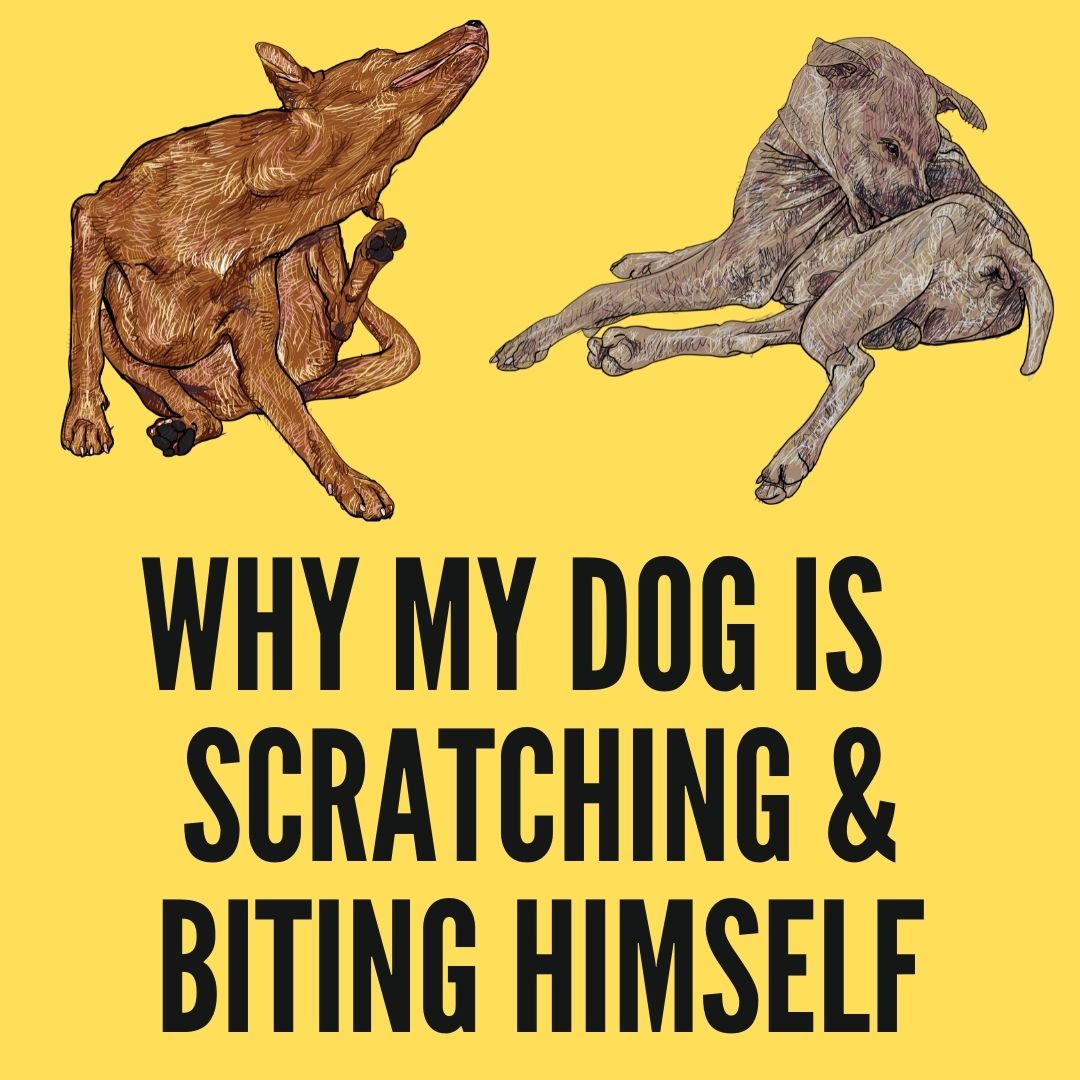Is your Cat or Dog scratching and biting himself? Well, Licking, chewing, and scratching behavior are normal and nothing to be worried about in the case of canines. But they have different reasons behind it. And some of them are very harmful. One of the most common signs is the development of hot spots. Hot spots are the wet, irritated, red regions that arise due to rubbing, scratching, licking, or chewing.
Although acute moist dermatitis or hot spots can occur anywhere on the body. But they are most commonly found on the chest, hips, or head. Because dogs constantly lick, bite, or scratch an area once it is irritated. Due to this, hot spots can be enlarged.
But what are the other reasons that make a dog lick and scratch himself constantly? Do all the dogs have the same problem? And what are its remedies? Let’s find out.

Contents
- 5 causes of constant scratching and biting
- How can I treat my dog’s skin problems?
- Other possible reasons for a dog to scratch and bite constantly
- Why does my dog keep scratching himself but has no fleas?
- What can you give a dog for severe itching?
- What is the best itch relief for dogs?
- How can you tell if your dog has a yeast infection?
- Final words
- Frequently asked questions
5 causes of constant scratching and biting
#1 Seasonal allergies
Your doggy may scratch and bite more in warmer climates when there are more mosquitoes and fleas in the surrounding. Also, the plants start to shed pollen.
Most of the dogs have no problem with pollen, but some of them have a genetic predisposition to allergies. When a dog has an allergic reaction to mold, dust, or pollen, the dog starts to bite and scratch excessively.
There is no way to treat your canine’s seasonal allergies, however, there are remedies that could reduce or prevent the symptoms.
Steroids like antihistamines and cortisone like Benadryl (diphenhydramine) have been used for ages to deal with dog allergies.
You need to speak for your vet before giving your canine allergic reaction medications — a vet can make sure that is the proper remedy for your canine and assist you to calculate the right dose, primarily based on your doggo’s weight.
Your vet might also advise different remedy options. There are numerous new immune-enhancing drugs, given both via means of tablet or injection, that is used mechanically, and are very powerful in dealing with pollen allergies.
Immunotherapy, a remedy that exposes sufferers to steadily growing quantities of an allergen, has been proven to lessen symptoms more than 1/2 of in the majority of allergic dogs.
#2 Flea allergies in Dogs
When fleas feed on the dog, they deposit their saliva into the dog’s skin.
This causes a transient inflammation for maximum dogs, however, a few dogs are genuinely allergic to flea saliva.
A non-allergic canine will nibble or chunk at a flea bite however not much more. However, if the canine has turned out to be allergic to flea saliva, the biting, itching, scratching, chewing, etc turn much more extreme and could close long after the flea is gone.
You can frequently discover fleas for your dog’s stomach, across the tail, and back leg. With cautious inspection, you may be capable of seeing the flea itself, which appears like little bits of black pepper.
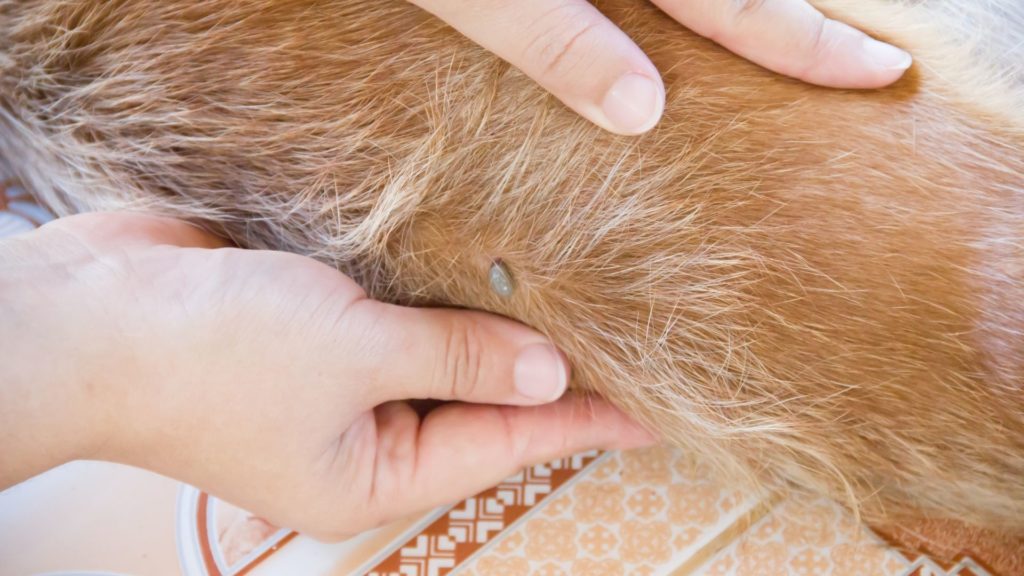
Treatment for fleas
- Comb out the fleas with a fine-toothed comb
- A specialised flea shampoo
- Vacuuming the home and clean your furry friend’s bedding
- Consult a vet
Highly allergic furry friends can also take advantage of well-known allergic reaction treatments like steroids or antihistamines to assist lessen inflammation and itching. Talk to your vet to see if this short-time period relief remedy is a superb alternative to your dog.
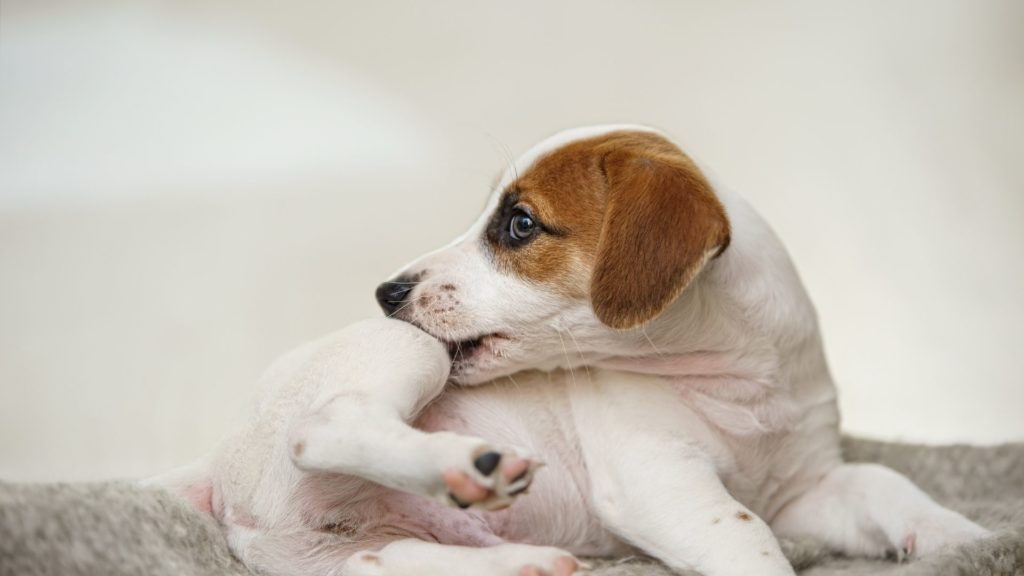
#3 Skin infections in Canines
Yeast infections and bacterial infections in your canine’s skin can also cause itching.
Though any canine can get skin infections, your doggo is at more risk if they have hypersensitive reactions or a disorder that causes hormonal imbalances.
The most unusual hormonal illnesses that can cause skin troubles in doggies are hypothyroidism and Cushing’s disease. Both make the skin greater at risk of yeast and bacterial infection that may bring itching.
To diagnose an endocrine disease, you’ll need to go to your vet to get blood testing for your dog. Once your vet has recognized one of these diseases, there are medicines to assist you to deal with your dog.
If there’s no underlying problem behind an infection, your vet can prescribe an antibiotic to deal with bacterial infections and an antifungal tablet to deal with yeast infections.
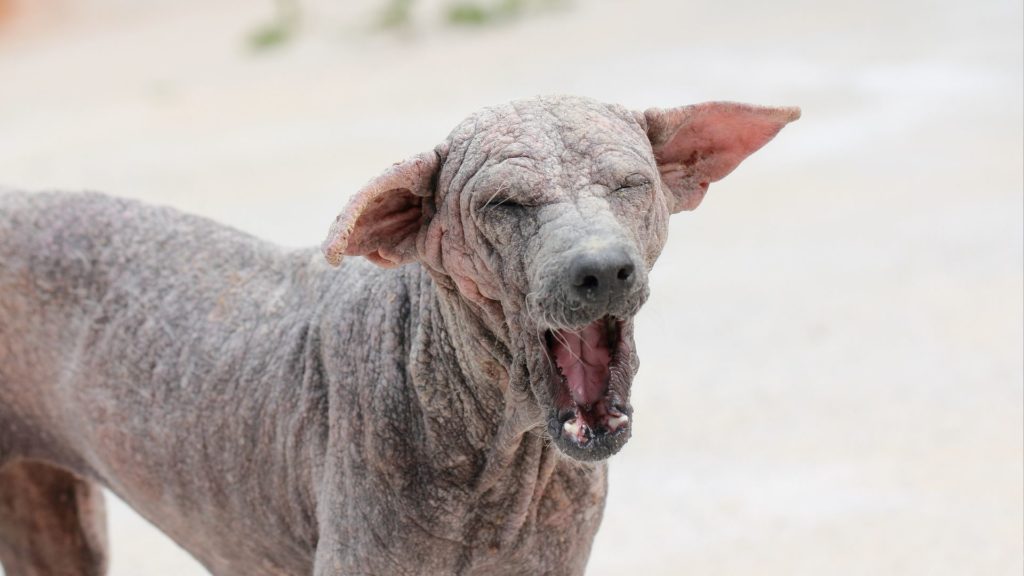
#4 Food allergies
If your dogy has a food allergy, they’ll have a reaction straight away after eating, however, signs and symptoms of food sensitivity can increase more steadily over time. Your dog may also start scratching, in conjunction with different signs and symptoms like:
- Unhealthy looking fur or skin
- Diarrhoea and vomiting
- Foot infections or chronic ear infections
If you watched your canine may have food allergies, your vet can assist you with the aid of placing your canine on a limited trial food regimen to decide which ingredients are inflicting the symptoms.
#5 Mange Disease In Dogs
Mange is a kind of skin disease that may cause extreme itchiness to your doggy. the different forms of mange include:
- Demodectic mange – Demodectic mange is also known as Demodex. It can be itchy but it is not contagious. Demodex is the overgrowth of mites present in your dog’s hair follicles.
- Sarcoptic mange – Sarcoptic mange is the itchiest mange in dogs. It is contagious and can pass from dogs to dogs. Sarcoptic mange is also known as scabies.
If your canine has mange, they are able to develop riming on their elbows, ears, and back thighs, however, they may be itchy in different regions too.
If you believe your furry friend can also have mange, consult your vet to perform a skin scrape and assist in the search for those mites.
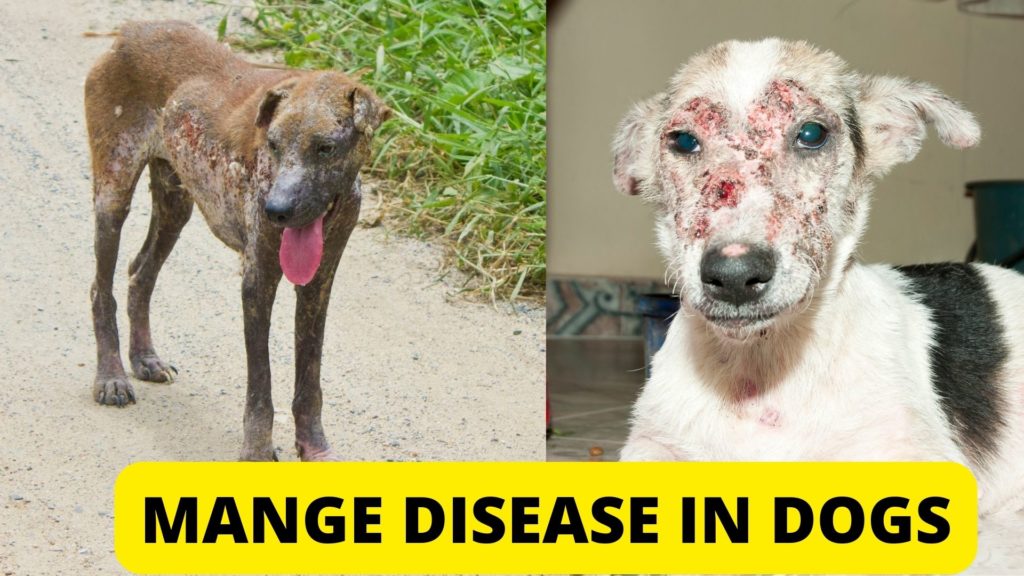
How can I treat my dog’s skin problems?
The exact treatment for scratching depends on the type of cause. However, there are different steps you should follow to relieve the itchiness. Sometimes, different approaches combined together can yield maximum results.
Here are some of the simple and effective ways to help your doggy to relieve this problem.
1) Use prescription medicines
You must use medicines that are approved and consulted by the vet. Your vet can evaluate the whole scenario and advise you on the best medicines for your dog’s condition.
For example, if your dog has an allergy then he needs corticosteroids and antihistamines. While another dog with skin infection needs topical treatment and antibiotics.
You must understand the fact that some medicines do not address primary issues, only the symptoms.
2) Go for anti-parasite treatments
Parasitic infection is a very critical disease for dogs as well as humans. While dealing with fleas you need to treat your dog and also clean the whole house thoroughly.
Mite infections can be very challenging and require prescribed medicines and antiparasitic shampoos in major cases.
Keeping dogs away from intestinal parasites needs frequent deworming. The deworming protocol depends on the dog’s lifestyle and age.
3) Change the diet
Food allergies are very common in dogs. Hence, giving your doggy a low allergy food may yield good results.
Look for the ingredients present in the old diet and make sure that the new one has different ingredients.
Raw diets allow you to choose different ingredients that are rich in nutrients. Also, they have minimal processing.
4) Limit the exposure from airborne allergens
Airborne allergens are hard to manage. Molds, pollen, and mites are everywhere and hence difficult to avoid. Therefore, stopping your pooch from going outside is impossible. But you can limit its exposure.
Taking care of the environment inside your house is quite easy. You just need to maintain the cleanliness in the house. Do regular vacuuming and install the HEPA filters for cleaning the air.
5) Clean your dog after walking
Instead of limiting your dog to go outside, you can focus on cleaning your doggo. For example, you can wipe your furry friend after daily walks. Focus on wiping the belly and paws as they are more contracted to allergens.
Understand this, wiping does not remove all the allergens. But, it can limit their number from entering your home. This also reduces the spread of allergens
6) Bathe the dog frequently
Bathing is the best way to remove the allergen from the coat and skin. Also, it removes the loose hair and mitigates the shedding problem. But, you must be careful before choosing the shampoo for your pooch.
Most dog shampoos dry the skin and can increase the itching problem. Hence, you have to buy high-quality shampoo that can moisturize your furry friend’s skin.
Other possible reasons for a dog to scratch and bite constantly
- Anxiety or boredom
- Dry skin
- Hormonal imbalance
- Pain
- Yeast
Why does my dog keep scratching himself but has no fleas?
- Food allergy
- Nutritional deficiency
- Environmental allergies
- Yeast infections
- Bacterial infections
What can you give a dog for severe itching?
- Oatmeal baths
- Chamomile
- Green tea
- Coconut oil
- Aloe vera gel
- Baking soda
What is the best itch relief for dogs?
Curaseb Anti-itch spray
vetWELL anti-itch spray
Vet organics anti-itch spray
Burt’s bees anti-itch spray
tropiClean oxymed spray
- Provides Fast Soothing Itch Relief from Allergies, Dry Skin and Skin Irritations
- Aloe Vera & Vitamin E; Soothes and Nourishes Itchy and Irritated Skin
- Relieves Itching, Swelling and Discomfort So Your Pet Can Rest
- Deodorizes with Pleasant Cucumber Melon Scent.
- Made in the USA
- Brilliant White: Produces a Lustrous Sheen on Any Light Colored Coat
- Soothing Oatmeal: Cleans and Conditions Your Pets Skin and Coat While Brightening Their Coat.
- No Harsh Ingredients: Our Tearless Formula Doesn't Contain Harsh Ingredients.
- Fresh Topical Scent: Leaves Your Pet Feeling and Smelling Refreshed.
- Quality You Can Trust: It's Understandable to be Worried About Products From Other Countries. At Pet MD, Our Products Are Produced in The USA in Facilities With Strict Inspection & Quality Controls.
- EASY SUPPORT – This spray promotes a healthy skin and coat for dogs and cats with hot spots commonly caused by allergies, insect bites, and dirty/matted or wet coats.
- USE WITH SHAMPOO – Made with ingredients that calm and moisturize the skin, this cat and dog spray works with our Hot Spot & Itch Relief Shampoo and can be used in between washes.
- VET-RECOMMENDED – Paraben and dye-free, Wheat Germ Oil adds moisture to the coat while other powerful ingredients work to help scratching and gnawing at the coat.
- FOR DOGS AND CATS – Intended for topical use only, spray this non-irritating formula on pets over 12 weeks of age to help discourage compulsive licking and help alleviate itching.
- EFFECTIVE & AFFORDABLE – Our products are created with powerful ingredients at an affordable price. We know dogs and cats are more than just pets because we are pet parents too.
- DOG SKIN VS. HUMAN SKIN - Dogs' skin has a higher pH, so human grooming products can be harmful. This itchy dog spray keeps their coat healthy and without irritation, making it an essential part of your dog bathing supplies
- RELIEVES DOG ITCH AND CLEANS - This dog spray for allergies and itching has naturally derived honeysuckle to soothe while keeping your dog coat clean and soft - a must-have in your dog bathing supplies
- NATURALLY DERIVED INGREDIENTS– Safe & gentle dog spray with 95%+ natural origin formulas, formulated without chemical detergents, phthalates, parabens, or sulfates, as well as colorants and dyes
- KIND TO THE PLANET –Our dog grooming products are packaged in 80% post-consumer recycled bottles
- SKIN-SOOTHING HONEY - Burt’s Bees for Pets products use honey to naturally condition your dog's coat, nourish skin, and maintain the perfect pH balance for pets
- TANGLE REMOVER – Detangler spray for dogs & cats provides easier brushing by softening tangles, matted fur, & knots.
- SOFT & SMOOTH – Moisturizing dog & cat matted fur remover uses a botanical blend.
- FEEL-GOOD INGREDIENTS – Derived from natural ingredients, TropiClean detangler spray leaves fur silky-soft.
- ALL FUR TYPES – works well with fine, wavy & easily matted hair making this a goldendoodle must have!
- TROPICLEAN – Pair with our coconut-scented shed control shampoo and 2-in-1 shampoo.
How can you tell if your dog has a yeast infection?
Signs of yeast infection include:
- Sores
- Yellow and sticky discharge
- Red skin
- Itchiness
- Hair loss
- Greasy coat
- Smelly skin
- Flaky skin
- Thickening skin
Final words
- How to Make a Dog Poop Quickly? 5 Effective Ways
- Is My Dog Waiting In Heaven for Me? 5 Signs to Look for!
